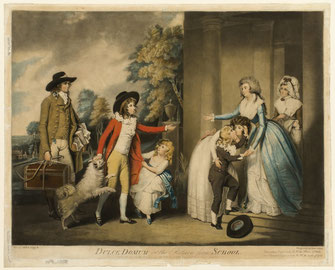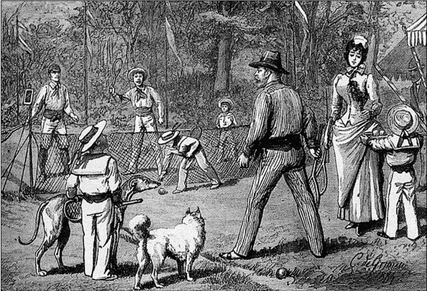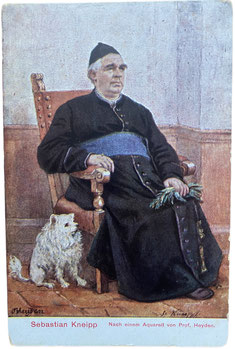VIPs and their Spitzes

The appreciation of a dog breed is probably most clearly shown in how art takes care of it and what sympathy the notabilities of this world show it. The German Spitz is definitely one of the breeds that have been immortalized in art since ancient times and that have found the favor of famous personalities. An image on a wine jug from Athens (400 BC) shows a young man with his Spitz. It can also be found on an Attic grave relief as well as on a mosaic panel in Pompeii or as a terracotta model from ancient Athens. In the Middle Ages it was found at the courts of emperors and kings as well as at the castles of princes and nobles.
The Tsarina Catherine the Great and her Spitz
You can do a lot of nonsense with him, as the Russian Empress Catherine II knew when she had a joke with her husband Peter III. performed. At that time, the Emperor of all the Russians had just suppressed an uprising among his nobility in the bud. One of his best friends took part and was sentenced to death as a result.
Who can describe the tsar's astonishment when his favorite Spitz, Lisette, came into the room to present her master in Maul with a petition from the death row prisoner? Since Lisette gave her a nice paw, the tsar was appeased and the false friend kept his life. As soon as this was confirmed, Katharina confessed to her husband that she had trained the clever dog to do this trick. Unfortunately, the tsar didn't find it funny at all, but was annoyed at having fallen for such a cheap prank.
Lisette fell out of favor and another Spitz named Henry became the Tsar's favorite because he believed that Henry was a good judge of character. But far from it: Henry was a friendly, open-minded Spitz, a so-called "everyone's friend" and this time too, his favorite Spitz was used to manipulate the tsar. So Henry was brought together with a supplicant whom he was supposed to woo. Since this acquaintance was made with a hot sausage, it goes without saying that Henry would later become extremely fond of this gift.

Empress Eugenie of France (1826 - 1920)
was a great lover of Miniature Spitzes. Eugenie was the wife of Emperor Napoleon III. and came from a distinguished Spanish noble family. At times, she represented the emperor in the French government in his absence. In her private life, however, she loved spending time with her dogs. Her favorite was a small white Spitz that she took with her everywhere. Once she lost him. She was very sad about that. Her husband, the Emperor, ordered an immediate search for him by the entire Paris police. Finally, the police presented her six Spitzes that looked exactly the same - and among them, she found her little darling.
On February 11, 1964, the "Westdeutscher Rundfunk" (West German Radio) performed a musical comedy on TV about this event under the title “Der Spitz im Zylinder” (the Spitz in the Silk Hat). Six white Miniature Spitzes from the German Spitz Club took part.
King George III of England (1760 - 1820)
had a magnificent Wolfspitz at Windsor Castle, which caused a stir at the English dog shows everywhere because of its beauty. The English Spitz breed as it exists today is the result of a fairly intensive breeding of Wolfspitz. Here - unlike in his home country of Germany - the Spitz was not a working dog, but was kept purely as a companion dog.

Price of Wales, later King Edward VII.
Was an avid lover of white Giant Spitzes.
King Wilhelm II of Württemberg
In her foreword to the exhibition catalog of the "Internationale Sonderausstellung der Deutschen Spitzerhunde zu Ludwigsburg" (International Special Show of German Spitz Dogs in Ludwigsburg) on May 19, 1957, the Princess von Wied wrote wonderful words about her royal father, the great friend of the German Spitz:
"My father was allowed to go home 36 years ago, and today he is still remembered by many - is this because of Ludwigsburg, the old traditional city, is it the once sung Swabian loyalty that resonates today - what special did he do that he was not forgotten? He was a person, simple and modest, who knew how to create a living monument for himself in the hearts of his contemporaries, who ensured that it remained alive. [...]"

"I feel all the deeper and more grateful for the attachment I have to him, to the simple man who guided Württemberg's fortunes for a quarter of a century. The crown meant to him the burden of responsibility and not the ornament of the ruler. They will ask: What did this simple man whom I had the honor to call father? It was his kindness to everyone and for everything. His name belongs here among the circle of Spitz friends and owners, because he was a permanent Spitz owner until the last years of his life. His Spitzes were allowed to do anything without having to fear resistance from their master. He once gave me a Spitz dog when I was only eight years old. Even today, many people still remember King Wilhelm II's walks with his Spitzes; it was the opportunity where wishes could be made without having to go through the official channels. So the Spitzers had become the involuntary mediators between the king and the people, even if they were not always so benevolent towards others."
Ali and Rubi the Spitzes weren't always very benevolent, so one or two coattails or a trouser fell victim to them. But no matter what the two of them did, the king always lost out on his two favorite dogs.

Crown Prince Wilhelm and Crown Princess Cecilie of Hohenzollern
Were enthusiastic, blue-blooded Spitz lovers. Many years ago an interesting article was published in an illustrated magazine under the article "Kronprinzessin Cecilie - Bilddokumente aus ihrem Leben" (Crown Princess Cecilie - photographic documents from her life). Among the published images was the Crown Prince in his hunting costume, with the Crown Princess sitting next to him with a magnificent white Miniature Spitz on her lap.
Michelangelo
One of Italy's greatest artists and geniuses had a magnificent white Spitz. The Spitz always had to be present during his work in the Vatican and in St. Peter's Church in Rome. He lay on a special pillow and looked at his master's artistic work.
Martin Luther
Luther was an enthusiastic friend of the Spitz. His Spitz was called Belferlein. Spitzes were big fashion back then. People probably had better nerves than they do today. Martin Luther, who was a great dog lover, one day got a "Spitzhund" who placed great demands on his master's patience. Come what may, the Spitz did what Spitzes like to do: they bark with passion. Luther's new acquisition was named Belferlein. “The good Belferlein won’t get into heaven either,” Luther is said to have once said at the table.

The people sitting there took this statement very seriously because they believed that the doctor from Wittenberg was fundamentally speaking against animals in heaven. In reality, this word was just a friendly reminder to Belferlein to take some precautions. Luther enjoyed talking to his Spitz in detail, as many dog lovers still do today. And don't worry: dogs also go to heaven - at least according to Luther's opinion:
"I believe that also the Belferlein
and all doggies go to heaven
and every creature has an immortal soul."
Wolfgang Amadeus Mozart
was one of the greatest and most brilliant composers in the world, and caused a stir at the age of six with his piano playing and his own compositions. Through strict discipline and tireless work, Mozart developed his gifted talent to full artistic maturity. In his free time he devoted himself to his Spitz “Bimperl”. Mozart's Spitz howled loudly during his compositions.
Mozart firmly believed that his beloved Spitz would take a keen interest in family life. Mozart asked about Bimperl in many of his letters during his travels. Only when his wife wrote to him that the Spitz had howled miserably while playing various pieces of his master's music did he receive the instruction in the letter: "If Spitz howls so much again when you play my compositions on the spinet, give him a few good slaps in the face. But for God's sake, don't let him suffer anyway."
Bimperl got older and older. His master loved him more and more every year. One day he surprised his wife and dog with a composition dedicated to Bimperl. It began:
“You certainly cannot be disloyal.
Oh no, oh no, my Spitz!"
Unfortunately, this song remained unfinished.
Naturalist Newton
The great researcher, who wrote almost all of his works in the presence of his cat and his Spitz, Diamond, suffered greatly from the dog that liked to eat paper. As soon as his master had left, Diamond began to chew up the manuscripts until not a readable scrap remained. It was far from the case that the naturalist was beating his dog: "There are two options" he said in such cases, "either you acted as your nature dictated, or you are an instrument of higher powers and the work was inadequate. I will begin again."
The poet Jean Paul
The poet also took his Spitz, who does not seem to have had a special name, very seriously. Now and then he received invitations to meet this or that person, whereupon the poet immediately asked whether his dog had also been invited. If it was clear from the answer that they wanted to do without the dog, the poet didn't come either. However, things became serious when Duke George of Saxe-Meiningen came up with the idea of introducing a general dog ban in the fall of 1802. According to this order, no four-legged friend was allowed to pass through the city gate because there were too many poachers doing nonsense in the area on the royal hunt.
Jean Paul sat down and wrote a touching petition for his Spitz, which has the following curious wording: "Unfortunately, due to some bad poachers, we have all been placed under city arrest. Since we have little sense, I can't write anything up. Therefore, my master made the trouble to make a petition that I can follow him when he goes to Welkershausen or Grimmenthal. I can provide certificates from my principal that I know as little about hunting as he does, and I am always the closest person behind my master's stick. Since you have often had the grace to pet me when you were with him, I hope that I would be allowed to do so in the future to get in front of the city gate."
This begging Spitz, who was bitten and killed by a rampaging dog, wasn't lying. A Spitz knows no more about hunting than a poet. He is almost the only dog that refuses to chase after rabbits, rabbits, and even cats. For him, master and house are completely sufficient for his well-being, and it is said to have happened in many areas that hunting tenants made Spitzes available to the surrounding farms if the farmers undertook to get rid of the existing poaching dogs. A Spitz that stays not at home is not a real Spitz. He is the good housefather among the many dog breeds. But we know that overly well-behaved housefathers occasionally get on your nerves when they want to talk into everything and anything. If a good Fox Terrier gnaws through his leather leash in a very short space of time when he senses a desirable adventure in the distance, for a good Spitz a single word is enough, and he will sit in the same place you assigned him for hours. So it is also the conservative, contemplative citizens who love their kind in Spitz.

Pastor Sebastian Kneipp
Sebastian Kneipp was also a friend of the German Giant Spitz. In his “Biographischen Studie" (Biographical Study) about Kneipp, Dr. med. Baumgarten wrote: "Yes, the Spitz! Without him, you never actually saw our old gentleman. His spa guests tried to make friends with the Spitz."
The Spitz was not only allowed to enter the sacristy, but also into the consultation hours. There he always sat under the table at Pastor Kneipp's feet and watched the sick. It is said that His Imperial Highness, Archduke Joseph of Austria-Hungary, who was good friends with Kneipp and regularly came to Wörishofen for treatment, once offered Pastor Kneipp a cigarette during his consultation and wanted to give him a light. The Spitz seemed uncomfortable with this and bit the Archduke, who was wearing Kneipp sandals, on the big toe. Kneipp, who noticed this, immediately stabbed with his foot, but boom, he was bitten by his Spitz too. It was nothing serious, but the Archduke is said to have only gone to consultations wearing boots.
Painters
A lovely picture also comes from the painter Piltz called “Bei der Cappeler Mühle” (At the Cappel's mill). The miller's boy, next to whom his stocky, well-haired Spitz stands, meets a girl at the mill.
The well-known animal painter Sperling also liked our Spitz. Who doesn't know his well-known picture "The Agitator"? Among the dogs of all breeds listening to the poodle portrayed as a speaker, there is also an adorable white Spitz displayed.
Among the visual artists, the painter Ludwig Richter never tired of using the Spitz in his emotional depictions of German folk life and portraying him as a friend and protector of children and the common people.
Bilder von Ludwig Richter

Empress Farah Diba
The wife of the last Persian emperor, Reza Pahlevi, was a friend of the German Miniature Spitzes and herself had a small Orange Spitz who was the favorite of the imperial family.
Heinz Rühmann and Marianne Koch
Heinz Rühmann and Marianne Koch, important actors in German film, were also friends of our white Spitz. At a press tea for the Berolina production in the Hotel Excelsior in Cologne on the occasion of the world premiere of the film "Being a Father, Against It" in the Ufa Palace, the two actors appeared with their white Giant Spitz "Bello".
Alexander Wahl
The famous Austrian sculptor of the 20th century immortalized his Wolfsspitz from kennel “Cäcilienhof” in stone.
Joseph Faßbender
The Cologne painter Joseph Faßbender, winner of the art prize in 1957, was a great admirer of the white Spitz.
Elvis Presley
The singer was a big animal lover and had a Spitz or Eskie named "Edmund", which he gave to his aunt because the two got along so well.
The German Spitz (and especially the Wolfsspitz) found and still finds its lovers everywhere: with actresses like Theda Bara, in royal families like Sonja of Norway, with the Irish poet William Butler Yeats and also with film producer and comic artist Walt Disney.
The German Spitz was revered in both English and German royal families: Queen Victoria of England, who had a great influence on the development of English Spitz breeding, also kept Spitz, as did her son King Edward VII, Prince of Wales, and his son King George V of Wales. The German Spitz had other blue-blooded friends in Princess Diana and Princess Mary of Wales.
Many famous actresses such as Magda Schneider, Brigitte Helm, Lillian Harvey, Janet Leigh and Ginger Rogers were also big fans of our Spitz - rightly so, in my opinion!
05.09.2023






























